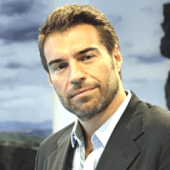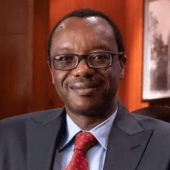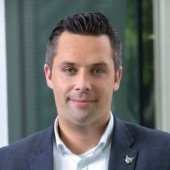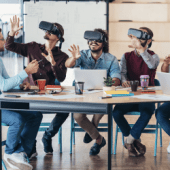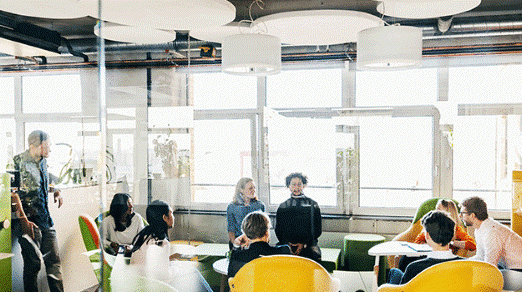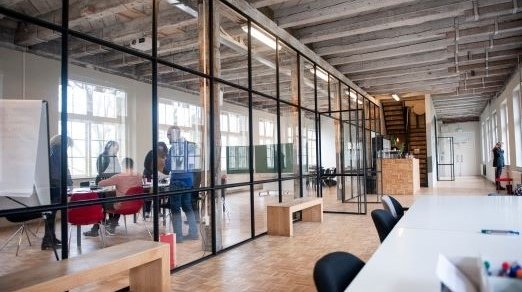Next-decade office design: A discussion with HGA architects on form, function and the future
IN BRIEF
- 9:05 - Data is amazing but be careful, because people don’t know what they don’t know. So, one of our clients had a ton of survey data for us and almost all of it said that their employees wanted to come in two days a week. As we started doing user group meetings, we heard overwhelmingly that almost no one planned on coming in two days a week.
- 15:25 - We’ve seen a huge increase in building more outdoor space for meeting, for eating, for relaxing. There’s the obvious added safety of fresh air, but I think the more important thing is people realized how much they like being outside. We’ve definitely seen a huge shift to creating more productive office spaces outside.
- 27:42 - In the future, I think we’ll see the death of the 9-to-5 work day. Frankly, I think 9-to-5 has been dead for a while. Technology has enabled us to work synchronously, and traffic makes us not want to work from 9-to-5 because then everyone is on the road at the same time; it's worse for the planet. And so, because of our ability to do all of those things, I think the office becomes a zone for people who want to work there because it’s better for them to work there.
Where will we work in 2030? What will it look like? How will it function? These are big questions facing business leaders worldwide, and to get some answers Joe Kornik, Editor-in-Chief of VISION by Protiviti, welcomes HGA’s Melissa Pesci and Haley Nelson to the VISION by Protiviti podcast. HGA is a Minneapolis-based national interdisciplinary design firm rooted in architecture, interior design and engineering, and both Melissa and Haley specialize in workplace design supporting clients nationally. On the program, we discuss the future of the office, specifically its design, and Melissa and Haley have some interesting ideas about form, function and the future of the workplace in 2030 and beyond.
NEXT-DECADE OFFICE DESIGN: A DISCUSSION WITH HGA ARCHITECTS ON FORM, FUNCTION AND THE FUTURE - Audio transcript
Joe Kornik: Welcome to the VISION by Protiviti podcast. I’m Joe Kornik, Editor-in-Chief of VISION by Protiviti, where we look into the future to examine big topics that will impact businesses worldwide over the next decade and beyond. Today, we’ll focus on the future of work and, specifically, the future of the office and its design and overall functionality in 2030 and beyond, as we welcome HGA, a Minneapolis-based national interdisciplinary design firm rooted in architecture, interior design and engineering. Today, I’m excited to be able to welcome HGA’s Melissa Pesci and Haley Nelson to the program. Melissa and Haley both specialize in workplace design, supporting clients nationally. Haley and Melissa, welcome to the program.
Haley Nelson: Thanks, Joe. Excited to be here.
Melissa Pesci: Yes. Happy for our conversation.
Kornik: I’m excited for our conversation today because this is such a fascinating part of this topic, the future of work, that we’ve been exploring for the last several weeks. Offices in 2030 and beyond will be very different spaces in what they look like, and how they function will go a long way to determining how we function as workers.
We certainly want to keep this focused on the future, in a decade or even more out — that’s what this program is all about. But I am going to start a little more near-term, and what the last two years have been and their impact on what it means for the future. So, let’s start with the pandemic, even though I don’t want to, but let’s start there. As much as I’d like to be past it, can you put the pandemic in context? Are we where we can start to realize its overall impact on the future of the office, and when we look back, let’s say, 10 or even 20 years from now, when we look back on COVID-19, would we view that as a turning point for the corporate office? What are your thoughts on that?
Nelson: Yes. It’s undeniably been a turning point for the corporate office, and we, for sure, can start to get that perspective even in the near term. This experience has given most office workers a completely new perspective on pretty much everything associated with working in an office, which is a pretty radical moment. People are able to assess what it means to have to commute, the way we connect with each other, our access to information, even the travel time between meetings. People were able to experience freedom from how, when and where their organization expected things to get done. That was starting to happen before, but we were all in this global experiment.
Our original research shows that people enjoyed having that license, that freedom to choose. We learned that there were pros and cons to working from home, and that there were things that the office could learn from these experiments. But I know we’ll get into it deeper, especially as we forecast into the future. But this moment amplified a lot of things that we were already designing to with our clients — spaces for activity-based working, and choice to work in alternative spaces in the office, not just at a desk, and designing for the health and wellbeing of people.
Pesci: Yes. Those are great points, Haley. The office has always been a tool, just like a computer is a tool. But historically, it’s been hard to measure the ROI of an office, because as office workers, we’re conditioned to amplify the efficiencies of being in an office, thinking about any ambient learning that’s happening. Often, we call that mentorship, but that’s a more active approach to learning, whereas ambient is learning from the people around you. So, we’re calling that, more and more, apprenticeship, because you’re learning while you’re doing your job, and you’re not having to take that extra step. Then, typically, managers are used to walking around seeing their employees that they’re working with and understanding what’s happening, as opposed to directly reaching out and finding out what’s going on. So, it’s those efficiencies that we’ve been conditioned to in our work life because we are all together in an office.
Kornik: We started with the pandemic. Let’s move a little forward, if we could — maybe a year or even three to five years out. What does business look like now, let’s say, over the next 12 months, and then, if we push that out to, say, three to five years, what’s your outlook right now?
Pesci: I’m going to back up for a second, because it was amazing to us how quickly our business pivoted in March. It was instant. All of our clients reached out, and they wanted to understand how they were going to keep going and how their employees were working. It was great, because we were able to see how things were working and then dial into how people were working from home.
We did a ton of research — we did surveys, user group meetings, observations — and then we tested a lot to see how people were working and if we planned for something, did that work? In that way, we were able to help companies plan for things that they could try as things started to open up so that they were ready to hit the ground running.
Now, in the last two years, many companies gave up their office space rather than just have it sit empty. As I said earlier, it is a tool. It has a huge expense, and many are now wanting office space again but don’t know what that looks like, and so we’re helping a lot of companies right now “right-size.” I like to do air quotes around “right-size” because we don’t know what that right size is, but we’re still testing, and still trying to help our clients understand how they best use their office and why they have that space, and help them understand that we want to bring flexibility to the design that will allow them to pivot and change, because we know that change is going to continue to be inevitable.
Nelson: Melissa, if I can tack on to what you were talking about, shining a light on the iniquities of the rules, professions, tied to the office, a lot of what we’ve seen grow in our business that we expect to grow, especially in Los Angeles, where I focus my practice, it’s very much about the entertainment industry, and that, for sure, didn’t stop. There is exponential growth. Entertainment and streaming exploded as we all transitioned from our home workspaces to our sofas during lockdown. So, we’ve been designing those spaces where people are creating the content that we love to binge, which has been exciting, but a huge growth opportunity as well for us. So, as we look to the future, it’s also identifying, what are the types of work that still depend on space, and having a physical space, something that you can’t easily replicate at home?
Kornik: Right. I know business leaders right now are pretty confused about specifics and what this is going to look like, in trying to weigh the pros and cons of having a larger footprint versus a smaller footprint, or what that space might look like or how it will function. As you’re talking to clients about the future of the office from a strategic perspective, and as they look ahead, what are they most concerned about, and how can design help overcome some of those issues and concerns? What advice are you giving business leaders these days?
Pesci: We are in a very fortunate position of seeing this happen multiple times a day, as opposed to, most companies have their own experience that they can bounce things off of, and we get to collect all of those experiences in order to help guide other businesses. The biggest thing that we have to continue to reinforce is that it’s not a one-size-fits-all solution.
At first, every single business leader that we spoke to wanted to know what everyone else was doing, and so we were quick to realize that what works for one person or one company doesn’t work for everyone. So, the first question we always ask today is, “What does your office space mean to your company?” and we can use that answer to develop criteria and amplify the results that they want to achieve at the office space.
I’ve talked earlier a little bit about how it’s hard to measure that ROI, but we can certainly set criteria so that we can design the space for the experiences that those companies and individuals are wanting to have. I’m in the Bay Area, and it’s probably popular knowledge that office space has always been a huge recruiting and retention tool. So, for us, we spend a lot of time connecting the space to the mission of the organization so that people feel a part of that culture and a part of that shared mission.
The second thing that we try to reinforce is, evaluate what’s working better now than it did before and what’s not working better now than it did before so that we can rethink the office space to eliminate the cons. And then, be ready to change things as we test it, and people change how they live, because as much as people changed how they live when they worked from home, as people reenter, going back into the office space, they’re going to change again, and it’s not going to necessarily be going back to what they did before.
I have a lot of points, because I’m constantly talking to business leaders about this. The next one is that data is amazing, but be careful, because people don’t know what they don’t know. One of our clients had a ton of survey data for us, and almost all of it said that their employees wanted to come in two days a week. They’re, like, “Wait — everyone wants to come in two days a week.”
So then, we start doing user group meetings, and as that process carried on, we heard overwhelmingly that almost no one planned on coming in two days a week. Some people wanted to come in one day a month; some people wanted to come in four days a week. And so, if we had taken that data for what it was, we would have planned everyone to be there two days a week, and we would have been way off the mark. So, be careful with that, and realize that as people start to learn more and change, the data is going change, and it’s like that moment in time where the data is relevant.
Another thing that we realized is the decision-makers are typically senior business leaders, since that’s what this question is aimed at as well, and that those people typically can work remotely with no problems. They can have a little bit harder time realizing what it might be to be new to the workforce. So, recognize that everyone has their own personal biases on how they work versus how the organization works.
Another one is that managers have been trained to be around people, and so it can be hard for them to imagine what remote work looks like, because they weren’t trained to do that. So, while people are setting these decisions, they should get feedback from people throughout the organization, and keep in mind that they don’t know what they don’t know. I tell people to be cognizant of proximity bias, because if the leaders are in the office, people will come in to the office. If the leaders are not in the office, people will not come into the office. Be cognizant of the decisions that they’re making and the impact that it will have across the company just from seeing their behavior that’s happening.
Kornik: Some interesting points there, Melissa. People might want to drive by the office two days a week. I’m not sure they’d want to stop and go in the office two days a week.
Pesci: Maybe stop for a free snack.
Kornik: Talk to me a little bit about trends. What trends are you seeing right now in terms of strategic planning and design when it comes to the office of 2030 and beyond, both in terms of architecture and functionality, and what do those trends tell you about how we’ll work in the future?
Nelson: This is the million-dollar question. What are these trends? A little bit of reflection is needed to set the stage, because in the past, we know that the types of spaces that were more often on the chopping block for value engineering and projects in office spaces were the very things that employees attach the greatest added value to — the social spaces, the collaborative spaces, those spaces where they could gather and have their moments of respite between deep, focused work. And we know we need to create better versions of these spaces in the next evolution of the office, ones that people value. And you run the risk of them becoming almost empty tokens of what, to use Melissa’s air quotes, “office fun” should look like.
We see a focus on better high-value experiences and amenities. And it’s like going to a restaurant — sure, you can cook at home, but going to a restaurant elevates that basic task to an experience that is multisensory and has this delight, and you feel different after going out for that experience. So, in the future, we see that the human-centered approaches are going to be the ones that win. I mentioned that we’ve already been designing in this way for a long time, and honestly, it’s at the heart of what we do as interior designers. We design for the human scale and the human experience first, and companies that perhaps didn’t see the value in that or weren’t recognizing the ROIs Melissa was mentioning, they have to now.
The other trend we see is around digging into the pros and cons of when you bring people together in a hybrid way in that next evolution. Melissa mentioned proximity bias, which is something the office is going to have to try to combat, but also understanding the experience that they might be missing out if there’s this shift of a larger group being in person — having ways that people can also connect and contribute. There’s this physical anchor point that we know is going to be very important, but then, also having those opportunities for those that may be experiencing a little bit more flexibility, or having that choice to be able to engage in different ways. It’s policy, technology and space all together.
Pesci: Haley, I couldn’t agree more. We see a lot of our clients talking about solving everything through hybrid meetings, but we know that, practically, we’re not quite there yet with protocols, human behavior and technology. I recently joined an organization during COVID-19, and all of our meetings were completely virtual, and it was fine. I didn’t have anything to measure that against, but it was fine. Then, last month, we had our first hybrid meeting, where we had a few people in each room, and I was physically exhausted after the meeting in a way that I’ve never been before. Then, just this week, we had our first all in-person meeting, and it was so much faster, so much more productive. We were all there connecting with each other. Everyone spoke up when they have something to say, and it almost felt to me like a little bit of an experiment of how we’re doing with hybrid meetings and how we can start to think about how we change our behaviors to do better going forward.
As a result of that, we’re seeing, pretty much across the board, everyone wanting to incorporate more small spaces equipped with technology. We’re going to be going in and out of remote depending on what happens with human health going forward. And because protocols change depending on the company and most companies have decided that they value the ability for distributed teams across offices, across countries, people are going to be having remote meetings even if there isn’t any human health crisis. So, knowing that we need those types of spaces is something we’ve seen a huge increase of.
Then, the other huge increase we’ve seen is building more outdoor space for meeting, for eating, for relaxing. There’s the obvious added safety of fresh air, but the more important thing is, people realized how much they like being outside for fresh air, access to daylight, biophilia, birds tweeting, whatever it maybe. I’ve definitely seen a huge shift to creating more productive spaces outside that may have AV, access to power, light, heat, things like that, and that goes to Haley’s point about amplifying wellness of space and creating high-value areas that people want to be in.
Kornik: Yes, that’s interesting, and as soon as you said that, I thought back to that cool professor in college who, when you got a nice day, said, “Let’s go out on the quad, and let’s sit on the grass.” You’d totally remember that class. I forget all the others, of course.
We’ve talked a bit about business leaders so far, and I am curious: I’m fascinated by the disconnect, or if there is a disconnect — maybe there’s not — between how business leaders are viewing offices right now and how employees are viewing offices right now and in the future, of course, and how the difference between those two — essentially, the perceptions of the employees versus the business leaders — influences the design decisions that you make as you look at offices of the future.
Pesci: There’s 100% the disconnect oftentimes, and not in a bad way, but business leaders are focused to make sure that their business continues, and so the office space is an overhead cost. Again, I know I’ve said ROI fifteen times, but the reason we have office space is because it adds value and makes the business more successful. It’s the second-highest cost to an organization after the cost of the employees, so it needs to be meaningful and it needs to return on the investment that the company is spending on it.
So, what we’re seeing is, many business leaders want to preserve the office but they want to see it shrink if they’re going to strategically have employees working from home. There’s a cost to employees working from home as well, with additional technology needs, and many are funding furniture and equipment for the home as well. I recently saw a fact that pre-COVID-19, 64% of office work was heads-down focus work, and a lot of leaders are looking at that and trying to understand how they can make their employees happier by giving them the possibility to work from home but then also managing those costs.
Many are looking for the technology to help create that more seamless experience, whether that’s using Zoom or having better BPM structures, but we’re also seeing many of our clients looking at VR experiences to try to bring people together, or app technology that lets people know when others will be in the office so they can maximize their time and create shared experiences that matter more to employees.
Nelson: You’re so right, Melissa. Hearing you put that context around the business leader’s perspective and the disconnect makes me think of a way that I had heard this phrased: anchor points. Business leaders have the anchor point of what the office was before the pandemic, and this strong desire to want to go back to what that was because it wasn’t broken, so to speak, in their mind. Maybe there were things that weren’t working as well, but there’s this innate human desire against change.
We all want to go back to our comfort zone, so that anchor point for business leaders is backward, in a way. But the anchor point for employees is forward, because like we said, now, everyone has experienced this autonomy and this flexibility — and these have become so cliché, these buzzwords. But that anchor point is pulling the employees forward. So, inherently, you have that disconnect because those anchor points are different.
And employees are pushing back against mandates and being told to do something even if it’s in the best interest for the apprenticeship and the socialization and the connection to the brand and all of those things, and the great points, Melissa, that you have made. It goes back to human nature, this inherent resistance to being told that I must change. And so, because those anchor points are different, the change is inherently different.
All that being said, it comes back from the employee perspective, to experience, like I was saying before. I’ll put my L.A. perspective on, but the commutes are long and stressful, and our staff, particularly when we think about our own office, live sprawled out across the area. So, it’s not surprising that people don’t want to endure that five days a week moving forward. We know that when people are going to want to come in, because there are important moments to have those connections, and for all of the benefits that the office brings, that’s going to take effort and planning, and we want to make that an experience for people. And that’s what people are looking for: They want to know when they do come in that it’s worth it, and so it goes back to those high-value, high-experience-driven spaces.
Kornik: That’s interesting, and what we’re getting down to here is the main function of what the office is becoming. What’s your view? What’s HGA’s view on the main role of the corporate office a decade from now, let’s say?
Nelson: I’m going to build on something that Melissa introduced, but organizations have to fundamentally define the purpose of their office space. It’s no longer looking at who did something cool that I want to copy because that’s a recruiting benefit — I want to hire the talent that they have — it’s about being thoughtful, reflecting on what are the business needs that the office is actually serving for me, and encouraging an organization to decide, what’s the importance that they attach to that place that supports your people? That’s exciting to us, because nobody wants a copy/paste. Nobody wants a benchmark and saying, “Yes, replicate that.” It’s about creating something unique.
I’ve mentioned value experience a few times too, so that’s one of the themes in addition to ROI today, but the work experience, growth, overall satisfaction, choice and control, it’s giving people a sense of pride. The office is about creating all of those things to be able to bring their best selves to work so they can create value for their organization.
One thing that’s been missing in the remote working environment is the sense of community. As long there’s an opportunity for learning with a mentor, we know that that’s not quite as successful. We’ve all been on webinars where you’re trying to multitask and you’re not learning anything new — you’re just trying to spin a bunch of plates.
So, we see the importance of the office to be that place. We ask ourselves, “What would it look like if the office was like a university? What if the office could provide opportunities for learning, for community, in a way that it’s fulfilling when you’re there, and then when you have a more flexible day — maybe you’re working from home — that energy stays with you?” It’s like when you go to a great conference and you get that buzz, and then you go back and you’re energized. So, that’s what’s exciting to us, about the new role of the office and how it can become that hub. The purpose of the office in the future is to be that heart. It’s a little touchy-feely, I guess, but it’s the heart of the company, to bring you together and be that hub.
Kornik: What a great discussion we’ve been having. I have one more question for you, but before I let you go, this is the VISION by Protiviti podcast. What goes along with that is that we like to ask our guests to make bold predictions about the future. Our entire program is focused on a decade out, essentially. So, when you think about 2030 — and I’ll even put you even a little further, if possible, 2035 or even out to 2040, if you want to go that far — what haven’t we thought about? What may surprise us? Is there anything we haven’t discussed that you think will be part of that office of the future? Bold-prediction time, if you have any.
Nelson: We’re not short of ideas, but I do want to tie a little bit back into language. When you mentioned things that we haven’t discussed yet, what has come up so much, and what many organizations are leaving the door open to in the way that they’re talking about this, is about a “return” to something that was before — the tone and the messaging suggesting this transition back to something. The future of work in 2030 and beyond will have to look different. We can’t go back to the status quo that worked well for a time in the past — that’s just not how human innovation works. So, whether they realize it or not, with that language, they have an opportunity now to acknowledge that the future is different, and like I said, the only constant is change. One of the big things prompted by the pandemic and this rapid shift to remote working and how we’ve been working for the past two years is our relationship to time.
So, if I call this a bold prediction, we’ll see a rise in things that are automated, in automation. Automating the things that are routine allows for more time to focus on the things in people’s work that require the expertise, the creativity, the nuance and that human element. The overproductivity that was gauged during lockdown, when people were working more and producing more — which isn’t a gain, is it? It isn’t sustainable. So, we like to throw that productivity piece into this, but that’s not sustainable, that overproductivity that we know everyone was experiencing.
Businesses, of course, want to recognize those gains, so they’re going to have to rely more on the human capital to get to a sustainable future. That’s going to be prompted by that relationship to time. People and organizations recognize the disruption prompted by the pandemic, and the self-reflection that that change offered. Companies and people will further question where their time is most impactful, the time spent to maximize output for profit and the time people are willing to invest in their work to get the balance of productivity and satisfaction.
Pesci: Haley, I could not agree more. And to build on your idea of productivity, my very bold prediction is, we see America divorce from the 40-hour workweek. It’s a dated concept that’s not relevant to the way that we work. Back in 2014, Stanford did a huge research effort that showed that productivity drastically tanks after 50 hours in a week. When you break it down, for an eight-hour workday, people typically take two and a half hours of unproductive time during that eight-hour workday because of how much your brain is lagging, and burnout. Back in 2014, we used to call it presenteeism, because it was, you were in the office, but you weren’t productive.
We’re starting to realize, especially with the work-from-home, and we hear so much about lack of work-life balance, that we’re starting to try to figure out, “Are we productive for an hour and then need a 15-minute break, or two hours, so that we can get more done in less time?” Coupled with that, you see the death of the nine-to-five workday. Frankly, the nine-to-five has been dead for a while.
Technology has enabled us to work asynchronously, and traffic makes us not want to work from nine-to-five because then everyone is on the road at the same time. It’s worse for the planet. And so, because of our ability to do all of those things, coupled with Haley’s thoughts on the desire to increase productivity, breaks, work-life balance, the office becomes a zone for people who want to work there because it’s better for them to work there, but it’s more a place for teams to come together for predetermined periods of time, whether they are set locally or they are set globally — those moments that matter to get together as a team, innovate, be productive. And again, I hate to say it again, but maximize the ROI of that space.
Kornik: It’s a welcome change, and you’re right — we’re already moving in that direction.<>I’d like to thank you both for spending some time with me today. Melissa and Haley, thank you so much for joining the program today.
Pesci: Thank you for having us.
Nelson: Yes. Thanks so much, Joe. This was a great conversation.
Kornik: Yes, I enjoyed it. And thank you at home for listening to the VISION by Protiviti podcast. Please rate and subscribe wherever you listen to podcasts. And please be sure to check out vision.protiviti.com, where we have all of the content around our Future of Work series. Please subscribe to join VISION by Protiviti to sharpen your vision and make sure your business stays future-ready. For Melissa and for Haley, I’m Joe Kornik. Have a great day.
Melissa Pesci is a Principal at HGA, specializing in workplace planning and design. She collaborates with clients globally to reimagine the workplace as an incubator for innovation and entrepreneurship. She has more than 15 years of experience in space planning, interior design, program development and strategic planning for notable organizations in technology and professional services. Melissa speaks frequently at national design conferences and has been featured in leading industry journals. She has a Master of Architecture degree from University of Michigan.
Haley Nelson is an associate vice president and senior interior designer in the Los Angeles office of HGA. With expertise as a workplace designer and strategist, Haley focuses on the cultivation of original insights that support the creation of places for people and organizations to thrive in. Many of her projects have achieved the highest levels of certification for sustainability and wellbeing, have been published, and have won design and sustainability awards. Haley is a thought leader and has presented at numerous venues on how design can positively impact people.
Did you enjoy this content? For more like this, subscribe to the VISION by Protiviti newsletter.












